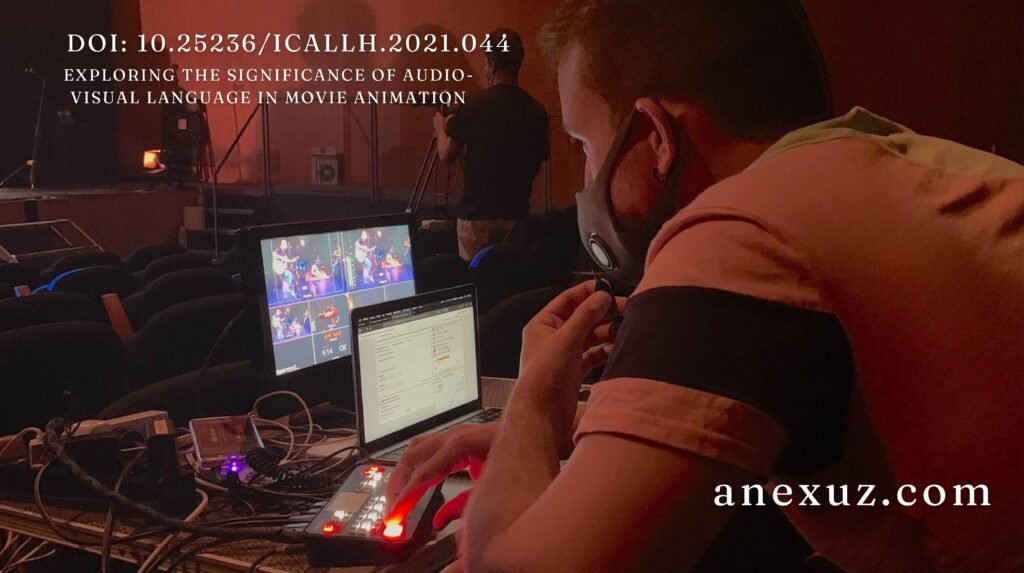Introduction
DOI: 10.25236/icallh.2021.044 : The following is the DOI for an academic paper presented during the ICALLH 2021: 10.25236/icallh.2021.044. The research study is related to the unique role of audio-visual language in movie animation, the development of which is considered to be a very dynamic field where visual art, storytelling, and audio effortlessly combine into some kind of symbiosis in order to enhance the experience of the audience.
This, together with the increased interest in animation by the film and television, attaches greater value to improve audio-visual language to tell any story or any form of narrative.
The purpose of this paper is to go further into discussion regarding how audio-visual language is formed and its character within an animated context and undertake a brief review of its possible future.
Basic Elements of Audiovisual Language in Animation : DOI: 10.25236/icallh.2021.044
Animation is the audio-visual language that brings integral harmony between the visual storytelling and sound element, immersing the audience into it. The term covers everything from lens design, scene scheduling, editing, and sound. It stands as a bridge between reality and fiction, allowing rich narratives not constrained by the limitations spelt by live-action films.
Unlike traditional film, which tends to spring from the real world, animation is often taken from an imaginary world of fairy tales and myth. Animation fabricates a story balancing fantastic imagination with telling.
This liberty in animation allows farfetched or surreally impossible elements to be given as unique audio-visual cues that result in a special emotional and sensory experience for the viewer. Creative intermingling of the visual elements with the sound elements brings depth into the plot and the characters in the movie animation.
Features of Audio-Visual Language in Movie Animation : DOI: 10.25236/icallh.2021.044
The transcendence of reality is perhaps one of the most outstanding characteristics of audio-visual language in movie animation. Being a craft taken through the lens, camera shots which are very real, live-action films might feel truer to life.
This, however, does feel like a highly driven game of imagination in animations. Larger artistic license given to a creator to experiment with surrealist imagery, colors, and soundscapes that will just be out of the realm of possibility in traditional films.
In most cases, action by character and the plot of the story are taken to the extreme, combined with the visuals of storytelling, such as shot design or editing. It furnishes them with ever more depth and layers of emotional force in plot development that invade and overwhelm viewers.
The ability of the author to plunge the viewer into some mythical or dreamlike virtual world-that hallmark of effective audiovisual language in animation-is sustained by this very basis.
The whole idea behind animation is that of imagination and creativity. The artists do not follow any reality bounds; they can completely create a world, characters, and the way these characters act. Then comes the job of audio-visual language to present these elements in just the right way that the audience connects with the story at an emotional and cognitive level.
For example, Chinese animation is a product of traditional expression forms combined with modern animation techniques born out of the cultural tradition of that nation. This therefore involves the use of lively color, stylized imagery and metaphorical sound to express historical and cultural stories and therefore the audio-visual language in Chinese animation is highly saturated by historical and cultural allusions.
Problems associated with audio-visual language development : DOI: 10.25236/icallh.2021.044
However, notwithstanding all developments in this area, the creation of audio-visual language for animation in movies encounters some challenges. First is that it is an art that has no special training or theorization.
Most audio-visual languages in animation are modifications from conventional film and television films, which seldom consider the needs of animation.
This has led to an imbalance in the level of exploitation that can actually be achieved in the complete and creative potential of audio-visual language in an animation movie.
Apart from indigenous and foreign investments, professional talent, too, stands in the way of the industry’s growth due to audio-visual animation-specific skills in short supply.
Much training in the art of audio-visual animation, due in part to the rather recent nature of such skill requirements, is based on traditional methods of film production and thus is relatively unsatisfactory for the changing nature of animation.
Hence, focused education to specifically suit the needs of the movie animation industry has been strongly called for.
Future Directions: Audio-Visual Language Moves Forth : DOI: 10.25236/icallh.2021.044
With increasing demands for higher quality in animation, the future of audio-visual language can only be promising in this medium. Audio-visual techniques keep on evolving as creators experiment with newer ways of telling stories with more advanced technologies that make the viewer experience even better.
Animation has much to offer regarding the creative heights that might be reached by the combination of the three: sound, visuals, and structure of narration, thus extending the frontiers of narrating stories through animated media.
The difficulty consists, for example, in creating a more systematic theory of audio-visual language for animation. More incisive scholarly research and creative new training programs-which can produce the animators and audio-visual specialists of the future-may enable more complex and emotionally resonant animated films to be made in the future.
Conclusion
DOI: 10.25236/icallh.2021.044 elaborates in detail the impact of audio-visual language in the shaping of modern animation. It is the characteristic ways of audio-visual narration that come to the fore in distinguishing between better animated films and their mediocrity as this technology develops further.
The present challenges have to be faced, specialist training programs need to be devised, and this medium will continue to thrive.
Audio-visual language, moving into the mainstream of innovation and creativity, will go beyond with its audience in its sway and take this form of storytelling further ahead. See More…
